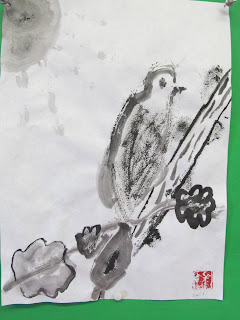Search This Blog
Sunday, March 24, 2013
Legos and Simple Machines
The third graders here at the New School have been participating in a Lego science class for the past several weeks. This class focuses on simple machine components, as well as forces and structures. Students are assigned to a partner and must work together to create daily structures. Past structures have included caterpillars (to demonstrate flexibility), folding chairs (flexibility), people, animals, bridges, various types of levers, and kick drums. Future lessons will entail wheels, axels, and pulleys. In addition to building with legos, the students have learned the proper name of each lego piece and important vocabulary words that pertain to each lesson. Past vocabulary words have included, but are not limited to: force, motion, levers, balanced forces, unbalanced forces, and pivot.
Wednesday, March 20, 2013
Microscopes
Our nine oldest students are participating in classes learning how to use a microscope and make slides. To start off this class and after watching a video on the parts of a microscope, students were paired and asked to find those parts on their microscope – which were all different from the video! This was more challenging than students thought as they got to explore all of the knobs and parts of their microscope. The following classes and centers found us exploring premade plant and animal slides, objects and then making our own slides! Students were very interested in looking at the homemade onion and spinach leaf cell slides. We even got a chance to dye our onion cell so that it was easier to see under the microscope. To finish off this unit, we’ll be looking at some human cells (cheek and skin) so that we can compare them to the plant cells we observed.
Sunday, March 17, 2013
Word Stretch
Once a week the
youngest students take part in a class called “Word Stretch” which gives the
students an opportunity to write words. Each class begins with the students
writing their names, the date and numbering their paper 1-6. As a group we
brainstorm a topic such as colors, pets or sports. Each student thinks of one
word that fits the category and one by one we “stretch” these words out
listening carefully to each sound we hear. The students write the words as best
they can, writing the letters that make the sounds they hear. After writing six
words, the students illustrate two of the words while reading their words back
to the teacher and adding any sounds they hear as they read it back. The object
of this exercise is for each child to record as many sounds as they hear, to
write the letters on the lines and to be able to read the words back when
finished. We do not expect the words to be spelled correctly. Nor do we expect
each child to hear all the same sounds.
Sunday, March 10, 2013
Biome Art
Children in the middle grades created landscapes of the biome they researched earlier in the year. First they were asked to consider where the horizon would be on their landscape. Then they considered the time of day. Would it be at dawn, dusk, at night or in the heat of the day. We talked about how the colors would change depending on their choice. After completing the sky children then drew the land without animals and plants. Finally the living things were added. Four or five of the animals were given dimension by being draw on a different paper, cut out and glued on their landscapes. The children used craypas.
Chinese Brush Painting
 After we learned about the aboriginal art of Australia we traveled north to the continent of Asia where we started learning about Chinese brush painting. We looked at slides and discovered how the Chinese "like to draw nature" and use "a lot of white spaces." Another child said, "The paintings are not all filled in." "They used very little paint. They do a lot with a little. They are minimalists." We watched videos showing artists effortlessly creating masterpieces and demonstrating the strokes. Then using bamboo brushes, black ink and rice paper children found the sweeping strokes of Chinese painting very liberating as they created their own masterpieces.
After we learned about the aboriginal art of Australia we traveled north to the continent of Asia where we started learning about Chinese brush painting. We looked at slides and discovered how the Chinese "like to draw nature" and use "a lot of white spaces." Another child said, "The paintings are not all filled in." "They used very little paint. They do a lot with a little. They are minimalists." We watched videos showing artists effortlessly creating masterpieces and demonstrating the strokes. Then using bamboo brushes, black ink and rice paper children found the sweeping strokes of Chinese painting very liberating as they created their own masterpieces.
Subscribe to:
Comments (Atom)












